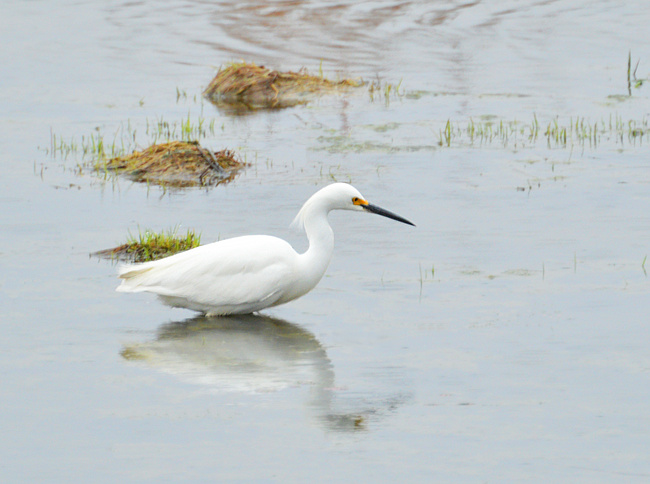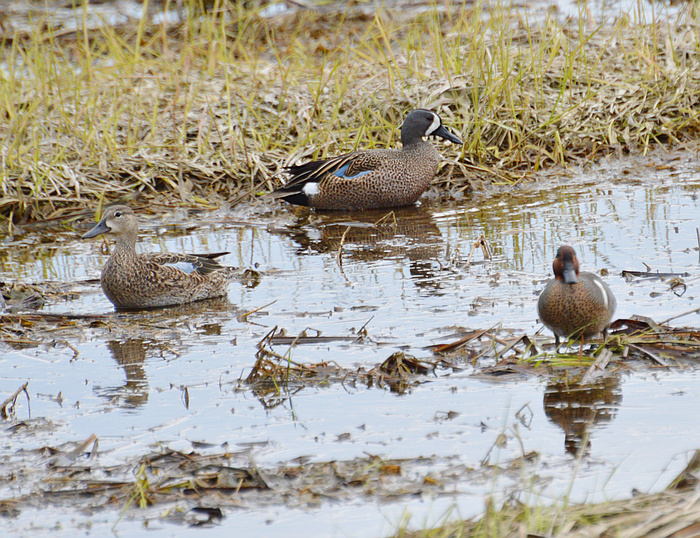
Recent Birdventures
May 3rd, 2018
1. Holland's Marsh
On the 25th I heard simultaneously from Jon Ruddy and Ontbirds that there was a rare Snowy Egret in a flooded field off Highway 17. I'd seen Snowy Egrets galore in Cape Hatteras, but never close to home, and a new "Ottawa lifer" is always worth chasing. Besides, I like Snowy Egrets! So I quickly looked up the directions and headed out.
I understood "Highway 17" to be what the 417 becomes when you keep going west, so was confused when the directions said to get off the highway at Kinburn, then turn left onto the 17. It turns out there is a tiny, disconnected, historical bit of Highway 17 near Kinburn. That's where the bird was. I saw it as soon as I drove up, foraging close to the road! I rolled down my passenger window to enjoy the view and the Ottawa-lifer.


Snowy Egrets look like half-sized Great Egrets (the large white herons that are becoming an increasingly common sight around Ottawa.) They breed on the south Atlantic coast, the Gulf coast, and parts of the western states. Once, they were nearly driven to extinction by demand for their beautiful white plumes (used to adorn ladies' hats.) Thankfully, the plume trade was stopped in time and their population rebounded.
A few minutes after I arrived, Bob Cermak came over and knocked on my driver-side window. "It's Sue, right? We just had a Ruff here about eight minutes ago. Seriously!"
Snowy Egret is a rarity. Ruff is a mega-rarity, an unusual species of sandpiper whose expected range is northern Europe and Siberia in summer, southern Europe, Africa and Asia in winter.
I got out and set my scope up, enjoying (and sharing, with one scopeless fellow) beautiful close-ups of the egret. And occasionally looking for the Ruff, though I wasn't at all convinced I'd know it when I found it. (I knew it wasn't going to be the extravagantly-plumaged breeding male. They'd have said so if it was. It was going to be a generic-looking brown sandpiper.) It was a rainy day and pretty soon I and the scope were both drenched. The scope is waterproof, me slightly less so, but the bird was worth it.
Then someone called out that he had the Ruff. Everyone got on it fast but me (embarrassingly), but I finally did. Lifer! (No photos of this one, sorry. It was extremely distant.) And a satisfying lifer. I was able to study it well, picking out the subtle features (the very short bill, the pot belly, the "floppy tertials") that had given away its identity to the sages.
Word got out fast and before long a couple dozen keen birders were with us, almost all of them clustered with scopes watching the distant Ruff while the Snowy Egret, some twenty feet away from us, putting on a beautiful show of prancing and preening, catching fish, shaking its little legs to stir up prey, languished in obscurity. (Not complete obscurity: I and a fellow photographer continued to lavish attention on it.) It was kind of funny. I imagined someone seeing this strange tableau and thinking, "Bird watching: you're doing it wrong."
I later found out that that spot is called "Holland's Marsh" in eBird...and literally nowhere else. Google knows all about a "Holland Marsh", but that's a region near Toronto, not a bit of flooded field near Ottawa. I don't get it, but who am I to question the birders hive mind? "Holland's Marsh" it is. And to Holland's Marsh I will return. (I gather it's considered a hotspot.)
2. Snake River Line
I was introduced to this great birding road thanks to one of Jon Ruddy's tours. It's famous for Sandhill Cranes, but I've since learned that it's good for a lot else, besides. It's a ways northwest from Ottawa, near Cobden, but from where I live it's only an hour drive. My last two visits have turned up seven different species of waterfowl, all hanging out in flooded fields, plus Bald Eagles, Northern Harriers, Rusty Blackbirds, Wilson's Snipe...the list goes on. The titular Snake River runs west of the road, surrounded by a large marshland (which has been proposed as a conservation reserve.) That marsh is probably why the birding is so rich, and why the fields flood.

From left to right: Female Blue-winged Teal, male Blue-winged Teal, male Green-winged Teal
I gather Snake River Line is underbirded. Because eBird keeps raising its eyebrows at me. 7 Greater Yellowlegs, really? 8 Northern Shoveler, really? 70 Northern Pintail, REALLY? Um, yes, really. I mean, it's not like these are tricky birds to identify, and it's not like I started birding yesterday. It's hard to get good photographic proof when most of the multitude are so far away, and I don't have a digiscoping setup (i.e. a means to take photos through my spotting scope.)
I'll be back. Next time I'm going to bring a playback device, so I can try to coax the Soras and American Bittern (taunting me from within the marsh) into showing themselves.
May 3rd, 2018
1. Holland's Marsh
On the 25th I heard simultaneously from Jon Ruddy and Ontbirds that there was a rare Snowy Egret in a flooded field off Highway 17. I'd seen Snowy Egrets galore in Cape Hatteras, but never close to home, and a new "Ottawa lifer" is always worth chasing. Besides, I like Snowy Egrets! So I quickly looked up the directions and headed out.
I understood "Highway 17" to be what the 417 becomes when you keep going west, so was confused when the directions said to get off the highway at Kinburn, then turn left onto the 17. It turns out there is a tiny, disconnected, historical bit of Highway 17 near Kinburn. That's where the bird was. I saw it as soon as I drove up, foraging close to the road! I rolled down my passenger window to enjoy the view and the Ottawa-lifer.


Snowy Egrets look like half-sized Great Egrets (the large white herons that are becoming an increasingly common sight around Ottawa.) They breed on the south Atlantic coast, the Gulf coast, and parts of the western states. Once, they were nearly driven to extinction by demand for their beautiful white plumes (used to adorn ladies' hats.) Thankfully, the plume trade was stopped in time and their population rebounded.
A few minutes after I arrived, Bob Cermak came over and knocked on my driver-side window. "It's Sue, right? We just had a Ruff here about eight minutes ago. Seriously!"
Snowy Egret is a rarity. Ruff is a mega-rarity, an unusual species of sandpiper whose expected range is northern Europe and Siberia in summer, southern Europe, Africa and Asia in winter.
I got out and set my scope up, enjoying (and sharing, with one scopeless fellow) beautiful close-ups of the egret. And occasionally looking for the Ruff, though I wasn't at all convinced I'd know it when I found it. (I knew it wasn't going to be the extravagantly-plumaged breeding male. They'd have said so if it was. It was going to be a generic-looking brown sandpiper.) It was a rainy day and pretty soon I and the scope were both drenched. The scope is waterproof, me slightly less so, but the bird was worth it.
Then someone called out that he had the Ruff. Everyone got on it fast but me (embarrassingly), but I finally did. Lifer! (No photos of this one, sorry. It was extremely distant.) And a satisfying lifer. I was able to study it well, picking out the subtle features (the very short bill, the pot belly, the "floppy tertials") that had given away its identity to the sages.
Word got out fast and before long a couple dozen keen birders were with us, almost all of them clustered with scopes watching the distant Ruff while the Snowy Egret, some twenty feet away from us, putting on a beautiful show of prancing and preening, catching fish, shaking its little legs to stir up prey, languished in obscurity. (Not complete obscurity: I and a fellow photographer continued to lavish attention on it.) It was kind of funny. I imagined someone seeing this strange tableau and thinking, "Bird watching: you're doing it wrong."
I later found out that that spot is called "Holland's Marsh" in eBird...and literally nowhere else. Google knows all about a "Holland Marsh", but that's a region near Toronto, not a bit of flooded field near Ottawa. I don't get it, but who am I to question the birders hive mind? "Holland's Marsh" it is. And to Holland's Marsh I will return. (I gather it's considered a hotspot.)
2. Snake River Line
I was introduced to this great birding road thanks to one of Jon Ruddy's tours. It's famous for Sandhill Cranes, but I've since learned that it's good for a lot else, besides. It's a ways northwest from Ottawa, near Cobden, but from where I live it's only an hour drive. My last two visits have turned up seven different species of waterfowl, all hanging out in flooded fields, plus Bald Eagles, Northern Harriers, Rusty Blackbirds, Wilson's Snipe...the list goes on. The titular Snake River runs west of the road, surrounded by a large marshland (which has been proposed as a conservation reserve.) That marsh is probably why the birding is so rich, and why the fields flood.

From left to right: Female Blue-winged Teal, male Blue-winged Teal, male Green-winged Teal
I gather Snake River Line is underbirded. Because eBird keeps raising its eyebrows at me. 7 Greater Yellowlegs, really? 8 Northern Shoveler, really? 70 Northern Pintail, REALLY? Um, yes, really. I mean, it's not like these are tricky birds to identify, and it's not like I started birding yesterday. It's hard to get good photographic proof when most of the multitude are so far away, and I don't have a digiscoping setup (i.e. a means to take photos through my spotting scope.)
I'll be back. Next time I'm going to bring a playback device, so I can try to coax the Soras and American Bittern (taunting me from within the marsh) into showing themselves.
| ← | → |
